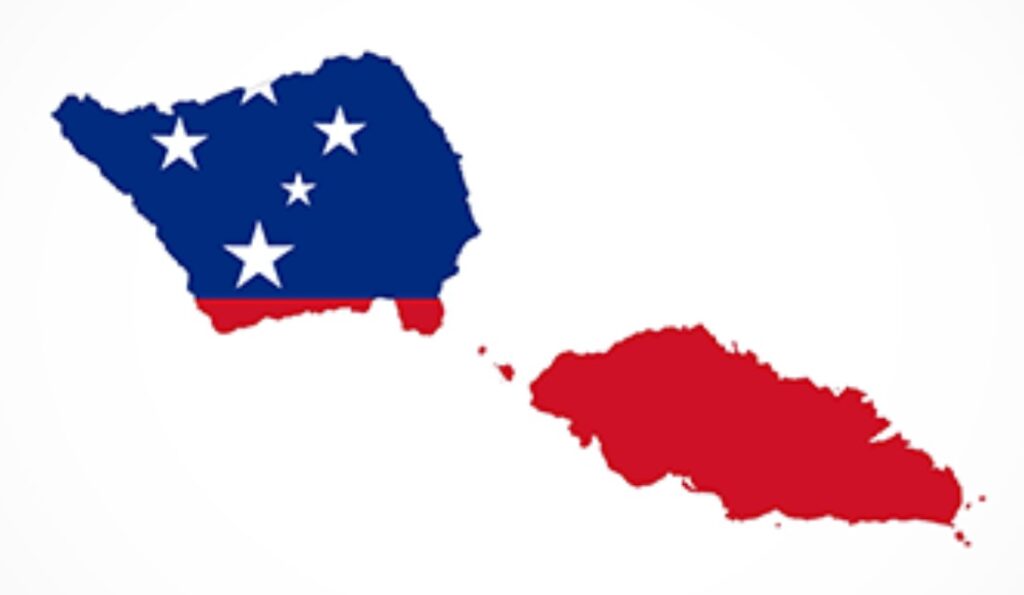
Samoa is a Polynesian island country (officially the Independent State of Samoa) and until 1997 was known as Western Samoa.
Between 1899 and 1915 it was a colony of the German Empire. It then came under a joint British and New Zealand colonial administration until 1962, when it became independent. The nation is made up of two main islands (Upolu and Savai’i), two smaller, inhabited islands (Manono and Apolima) and several smaller, uninhabited islands.
Samoa gained its independence from New Zealand in 1962 after more than a century of foreign influence and domination, but it remains a member of the Commonwealth. The country was known as Western Samoa until 1997. Its capital and main commercial centre is Apia, on the island of Upolu.
Fale is the Samoan word for all types of houses, from small to large. In general, traditional Samoan architecture is characterized by an oval or circular shape, with wooden posts holding up a domed roof.
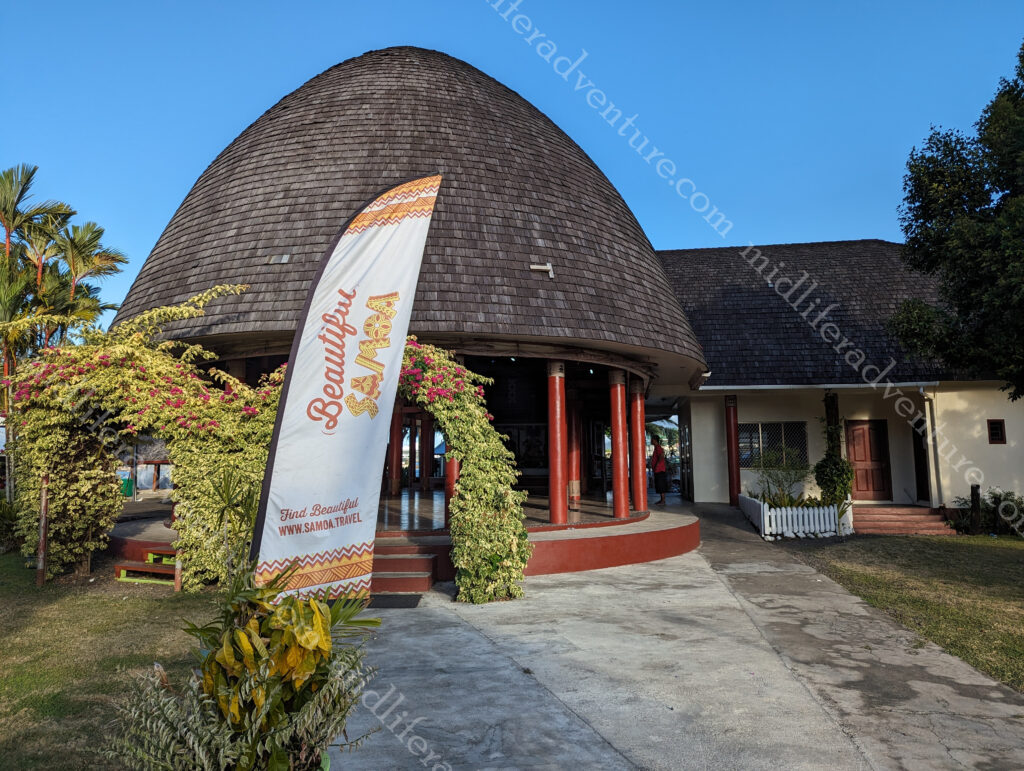
All of the building elements are ‘lashed’ or bound together, originally with a plaited rope made from dried coconut fibre. The fale’s open structure allows strong winds to pass straight through it, and the complex system of lashing offers flexible movement and strength in the face of ever-changing winds. The roof is curved allowing the winds that hit to move around its surface without meeting resistance.
The population of the Samoan Islands is around 225,000. However, there are another 240,000 in the United States, a further 183,000 in New Zealand and around 100,000 in Australia.
Upolo
Our arrival saw us land into the airport in the capital, Apia, on the island of Upolu. Apia is not seen as a town but 45 separate villages, but they are so condensed that it would be hard to make out the difference between them.
The overnight flight and lack of sleep saw us napping fairly early on after our arrival.
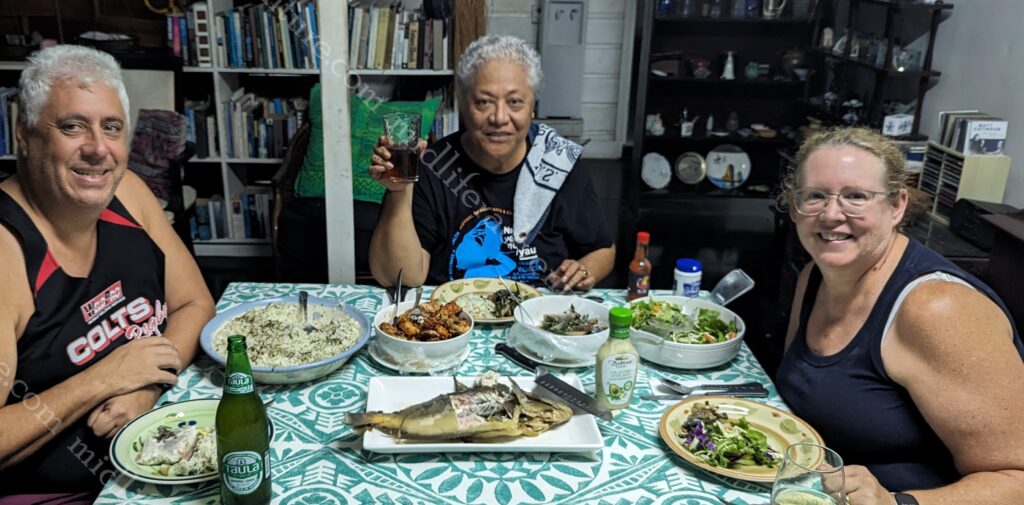
Thanks to Fiame, a close friend of my sister’s -and now close family friend- we had an offer of accommodation and even an airport pickup (at 5am) and unofficial impromptu tour guide (her cousin Pam).
On our first day after napping, Pam took us on a tour of the southern half of the island.
There is a ring road and a cross-island road so doing loops is a pretty easy and sensible way of splitting up your sightseeing.
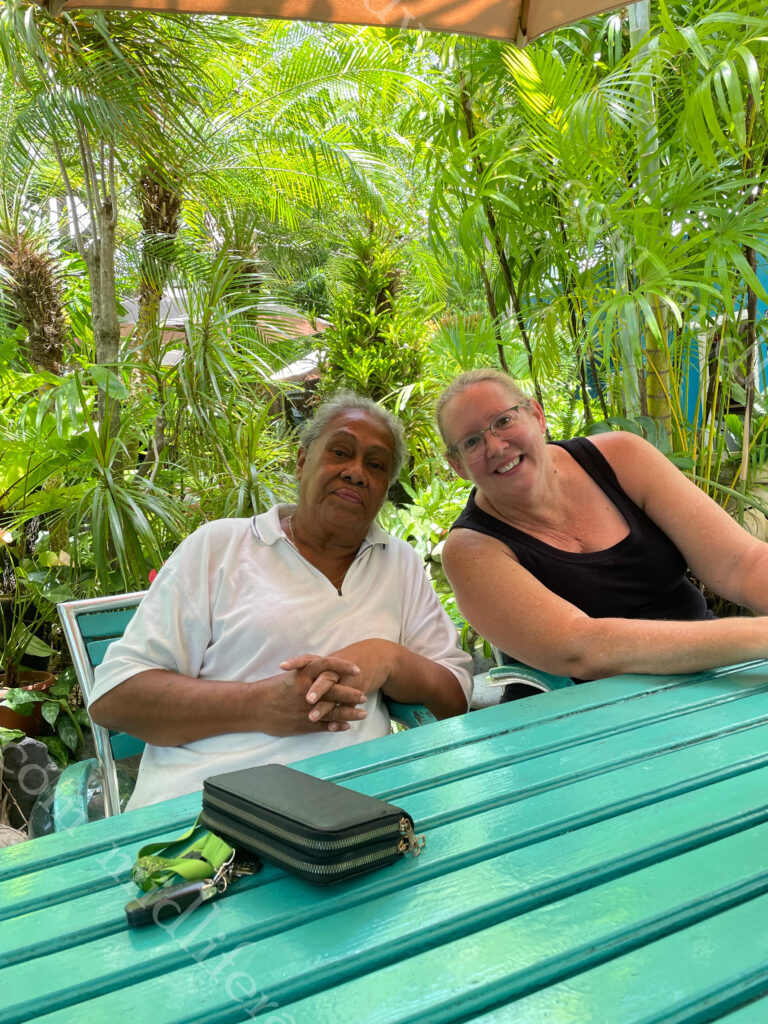
OK so meet the Banded Rail. These speedy little suckers are all over the place and while driving along they dart out onto the road, in front of the car and cause minor heart palpitations as you keep waiting for the bump (which never comes).
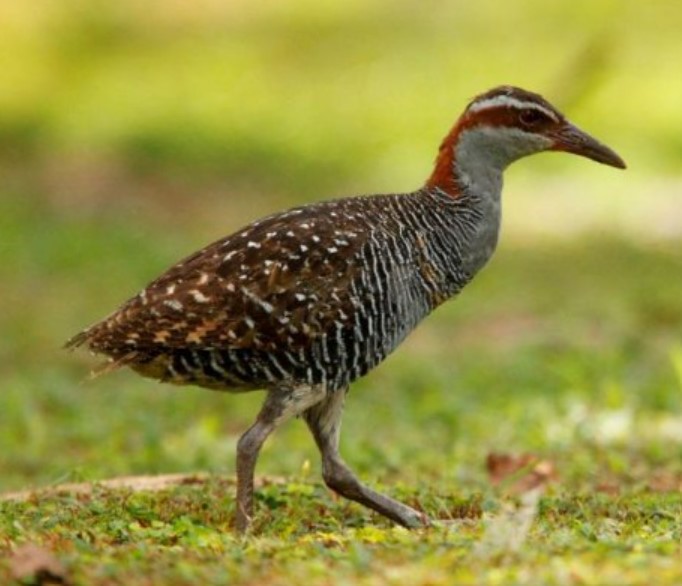

These cute little suckers are the next to meet as they are ubiquitous as they float around free range throughout the island.
The next thing that you have to meet is the Samoan local bus. These are highly colourful, with locally manufactured (typically wooden) cabins stuck onto old truck chassis. To say these are old clunkers is being very generous, but they do reek of style. To catch a bus, just wave it down – there are no bus stops. And when you want to get off, pull the cord along the roof of the bus. Simple!






All buses are named with their destination, but you may want to make sure and ask the driver if you are unsure. They run on ‘island time’, so using it for the airport run may not be advisable (unless you are leaving plenty of time).
The first among all of the tourist attractions in Samoa has to be the To Sua Trench. This is a spectacular 30-metre deep swimming hole. The blurb tells me that the hole was formed when an ancient lava tube caved in and thousands of years of erosion did the rest. And of course today it is full of bikini-clad tourists and an impossibly steep set of stairs to get down into the pool.



Around the To Sua is an amazingly lush landscaped area looking out onto the ocean. Some of the greenest grass and bluest skies that you will ever see combine to make this place simply amazing.






A short way down the road we found a nice secluded quiet beach near the village of Lotofoga where we were able to have a nice little dip, with the beach to ourselves (and Pam’s grandkids).





We checked the tourism “what’s on” and as luck would have it we were in town on the last Friday of the month, which meant that we were here for the Waterfront Night Market. So we headed on down to check them out. Unfortunately, the markets were not really supported and were little more than a sad bouncy castle, a couple of tents selling lavalavas (the Polynesian version of a sarong) and some carved wooden items (which customs would not let us bring into the country).
We did however get to see a very inventive version of a kid’s train.
The things you can do with a used 44 gallon drum.
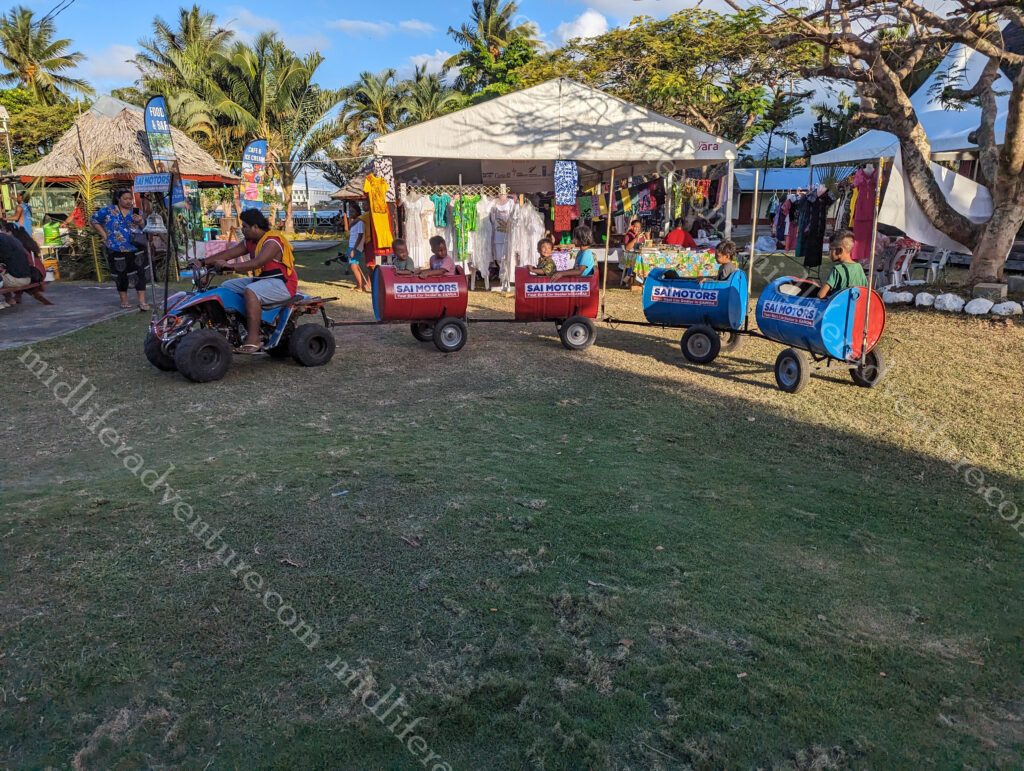
The market was held in the heart of town, at the Samoa Cultural Village. The Cultural Village features tapa making (traditional cloth), traditional tattooing (tatau), carving cultural artefacts, and the preparation of the “umu” (earth oven). Here is where you can learn about the Samoan Way (Fa’a Samoa). It is the essence of the Samoan culture and dictates how Samoans are meant to behave and their obligations to their elders, superiors, family, community, church and the environment.

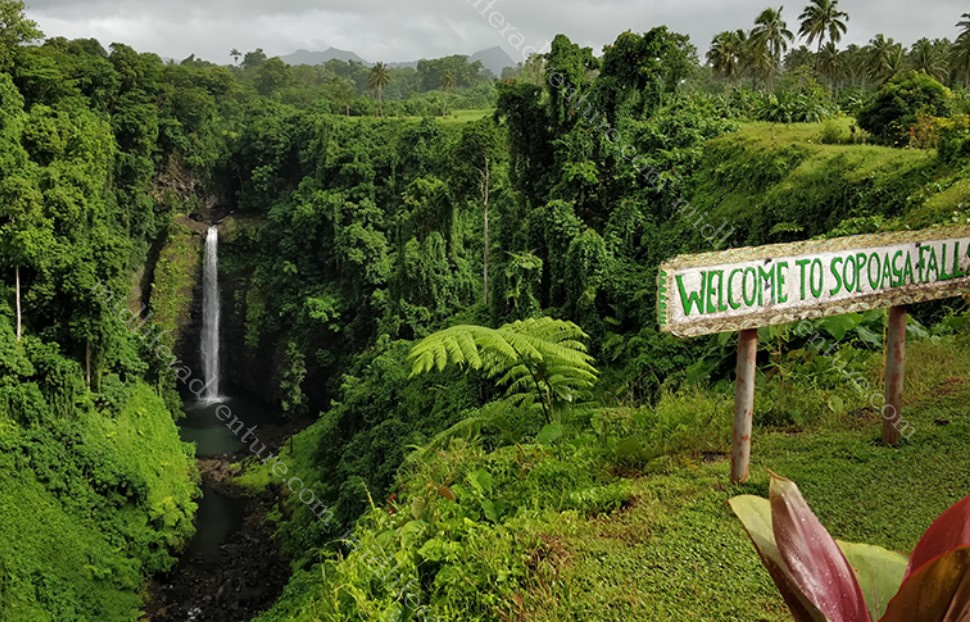
The Sopo’aga viewpoint is similarly easy to access off the Main South Coast Road and is probably the prettiest waterfall – it’s majestic in its dense jungle scene.
Papase’ea sliding rocks is a waterfall that has been worn smooth(ish) by the running water. While it is only 16 foot high, the slide has made it a favourite.
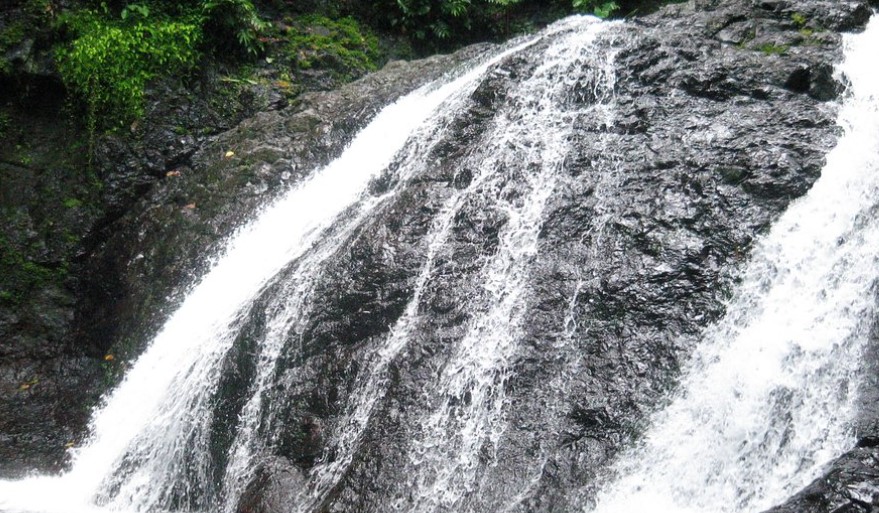
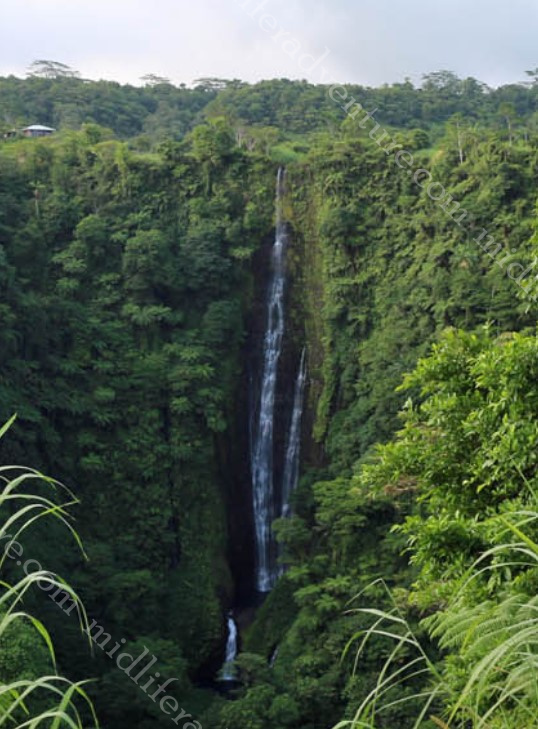
The Papapapaitai (I gave up even trying to pronounce this sucker) viewing spot is just off the cross island road.
These spectacular falls plunge 500 feet into a volcanic crater, surrounded by a lush rainforest. For these reasons, it is one of the most photographed falls in Samoa.
The next morning we were up early and did the schlepp to the fresh fish markets. Advice from the barflies was that this was definitely worth the effort so at 5 am we were up and walking the 2.2 km (each way) to buy ourselves some fresh seafood. Our haul saw us bring home about a 1.3 kg slab of yellowfin tuna, a fresh crab, and a couple of bugs, all for the princely sum of about $22.




A few days after our first trip of the southern part of the island, Pam again picked us up and we did the northern loop. This included a stop at one of the flash resorts for lunch, as nice as it may have been, that sort of thing just didn’t do it for me. The weather the second time around was not as kind with intermittent rain for most of the day (not enough to keep Jill out of the water though).










The Museum of Samoa is housed in a historic colonial building in Apia which used to be a German school. It contains a huge collection of artefacts and images which tell the story of Samoa’s history and rich culture. according to the blurb the museum is home to a pottery and stone adze which was discovered in Samoa and thought to be 3,000 years old. Given my love of old pottery, I skipped this.
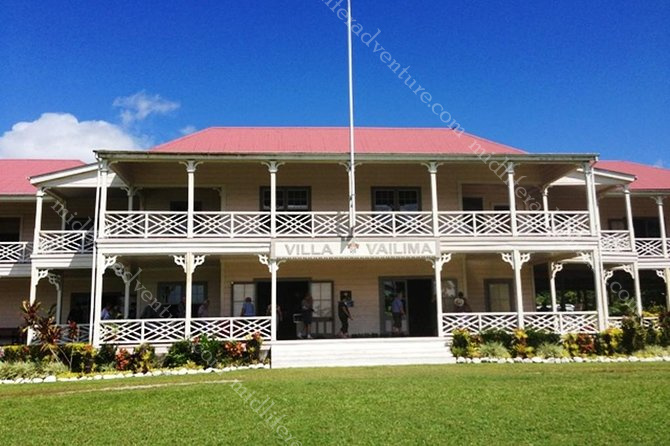
The famous Scottish author, Robert Louis Stevenson, spent the last 4 years of his life here in Samoa and is buried high on the hill overlooking the island.
His former residence has been converted into a museum that is dedicated to his life. On chatting with Pam my question was “is it worth going to or is it just a pretty colonial building”? Her answer was “just a pretty colonial building”. So we did the obligatory loop of the driveway, got a photo or two and left.
Church is at the centre of almost everything that it means to be Samoan. Every village has at least one church, and people actually attend them (religiously). The main show in town is right on the waterfront and is the Cathedral of the Immaculate Conception.





But quite literally, there are churches everywhere throughout Samoa. All of differing shapes and sizes. It is estimated that there are over 310 villages in Samoa and every one of these has (at least one) church. Going to church is central to everything that happens here in Samoa. So much so that virtually everything is closed on Sunday. Our chat with our impromptu tour guide Pam informed us that Sunday is for going to church, having a meal with your family and sleeping.






The Palolo Deep Marine Reserve is only five minutes walk from the centre of Apia (head east to Vaiala Beach) and importantly was about 150 m from our accommodation.



After a few days to ourselves and with Pam ferrying us about, our hostess returned from an overseas trip. Up until now we had been just milling about in her house as rather uncomfortable interlopers (being looked after by Utu the chef and Grace the part time cleaner). But after her arrival we were finally able to have a good catch-up (punctuated by amazing food yet again) and all was right with the world.
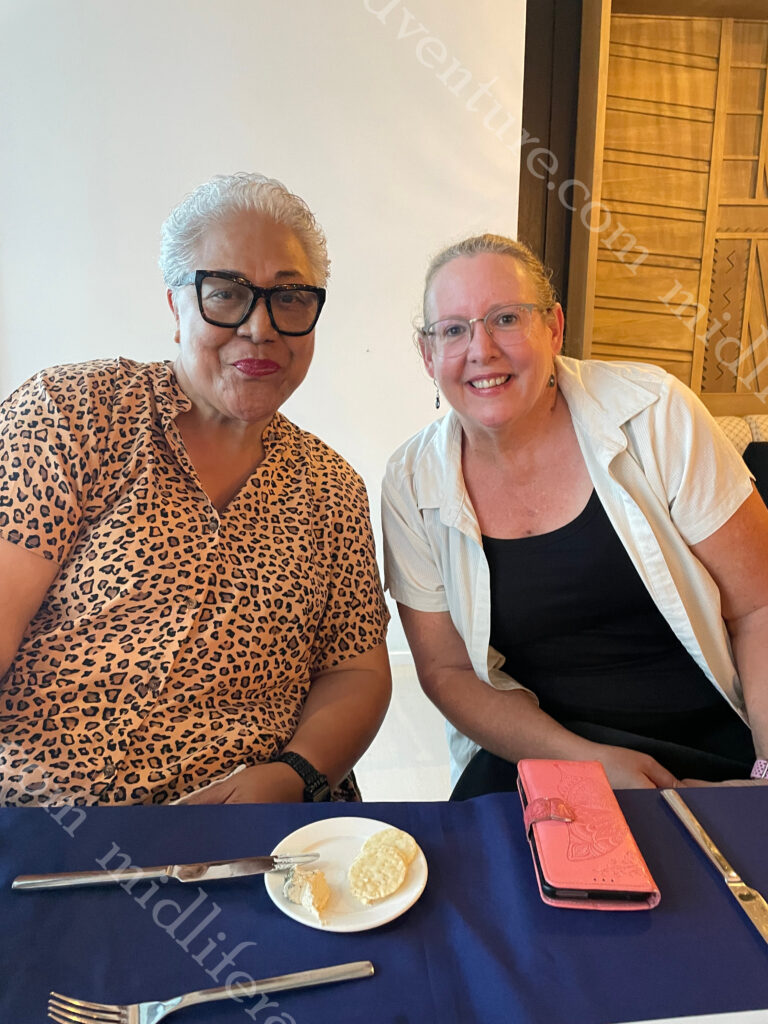
Talking to our hostess we were told that the Piula Cave Pool was her favourite and that it should not be missed.
So the next day we were up again and Pam picked us up and ran us out to this beautiful crystal clear freshwater spring pool and cave. The pool originated from an old lava tube and is now a crystal clear (if a little cold) pool to swim in.
This was followed up by another nice lunch and another great day was had.







Savai’i
Savai’i is the larger of the two main islands and at it’s centre is lies the volcano, Mount Silisili, the highest point on the island. Talking to the local bar flies (cos that’s where we hang out) they reckon that visiting Savai’i was like going back to the flintstones era.
In Polynesian mythology, Hawaiki is the original home of the Polynesians, before their dispersal across Polynesia. According to legend, Savai‘i island is said to be Hawaiki, the Polynesian homeland and is therefore known as the “Cradle of Polynesia”.
So we called on poor Pam once again, who met us at about 4:30am so that we could drive the 1 hr to the ferry terminal in time to make the 6am ferry to Salelaloga. A 90 minute ferry ride and we were on the big island and on the hunt for a rental car. The two main attractions that are on the island are the Lava field and the blowholes. Given that the blowholes were only 45 mins away (and it was low tide) the lady at the rental place suggested a right (rather than left) turn at the only set of lights. this way we circumnavigated most of the island seeing the sights while the tide rose.
Saleaula Lava Fields is a quick and easy stop as you traverse the island. A remnant of the 1905-1911 volcanic eruptions of Mt Matavanu the lava flowed northwards towards the coast destroying villages in its path. The lava flowed over 100 km2 of countryside and the depth of the lava flow in some parts was 400 feet. For a measly WST$10 (about $6) you can walk on the lava flow and see the impact it had on the village (including the swallowing up of the church). There is also a quick and informative history from the ladies on-site.









You used to be able to follow the lava flow down to the ocean but as it was aging the lava was becoming brittle in parts and they could not guarantee your safety so this was discouraged.
The next main attraction was the Falealupo Canopy Walk. I am finding that as I get older, the thought of heights is getting less and less appealing. Unfortunately, this one fit in firmly into that category. While I am happy to admire this, the thought of heading out along this walkway just didn’t tick any boxes for me.




Alofaaga Blowholes – These impressive blowholes are a major treat to see in real life.
Situated in the village of Taga on south-west Savai’i the blowholes shoot a roaring jet of water hundreds of feet up into the air.
They were created by lava flows making a series of tubes connecting a flat clifftop of lava rock with the ocean below.
As the waves break against the lower end of the tubes it sends water at high pressure up through the tubes making fountains that spray every few seconds.
The amazing thing was that there was no safety rails, just a red line spray painted on the rocks saying ‘stop here’. If the red line didn’t stop you then the roar of the water and the power of nature surely had to make you think twice. I am certain that some vacuous Instagrammers will push the bounds but the aussies and kiwis who were visiting when we were there all seemed to follow the very sensible advice provided by the spray paint.






Our accommodation on Savai’i was an issue and it started very poorly. Having booked our room (for 220) and paid our deposit, we were told our room would be 260 as the owner had put the rates up on the 1st of the month. After an argument that was poorly understood, we just paid the extra 40 and headed to the restaurant for a late lunch. At this point we were greeted by a menu of about 25 items to be told that all but 3 of them were not available.
We tried to ascertain whether more food would come before the dinner service (as there were very few restaurant options). After another unsuccessful chat, we ordered a burger and a club sandwich. When these arrived there was some bizarre salmon paste on both of them. Needless to say, salmon paste doesn’t work that well on a cheeseburger and Jill only managed one bite of her club sandwich.
As it turned out, dinner was a steak (that was ok) and the next morning the owner found us and apologised for the mix-up (for the room rate) and refunded us our extra 40. We felt infinitely better in the knowledge that the place did not suck, just that they were struggling with the training and retention of decent staff.
Samoan Food
Samoan food is relatively simple on first glance with the appearance of taro, breadfruit, rice and green bananas as staples. Add to this some various local fruits, salads and thin soups and the basics are done. But even the simple stuff is kicked to another level due to the appearance of coconut cream. My first foray into breadfruit and taro were pretty tasteless and were just a starchy filler. But the addition of coconut cream makes them both super yummy and not bland at all. And of course, then the rest kicks in.
Our first taste sensation was Palusami. A simple dish of taro leaves, onion and coconut cream.
Granted it didn’t look like much but the taste is amazing.

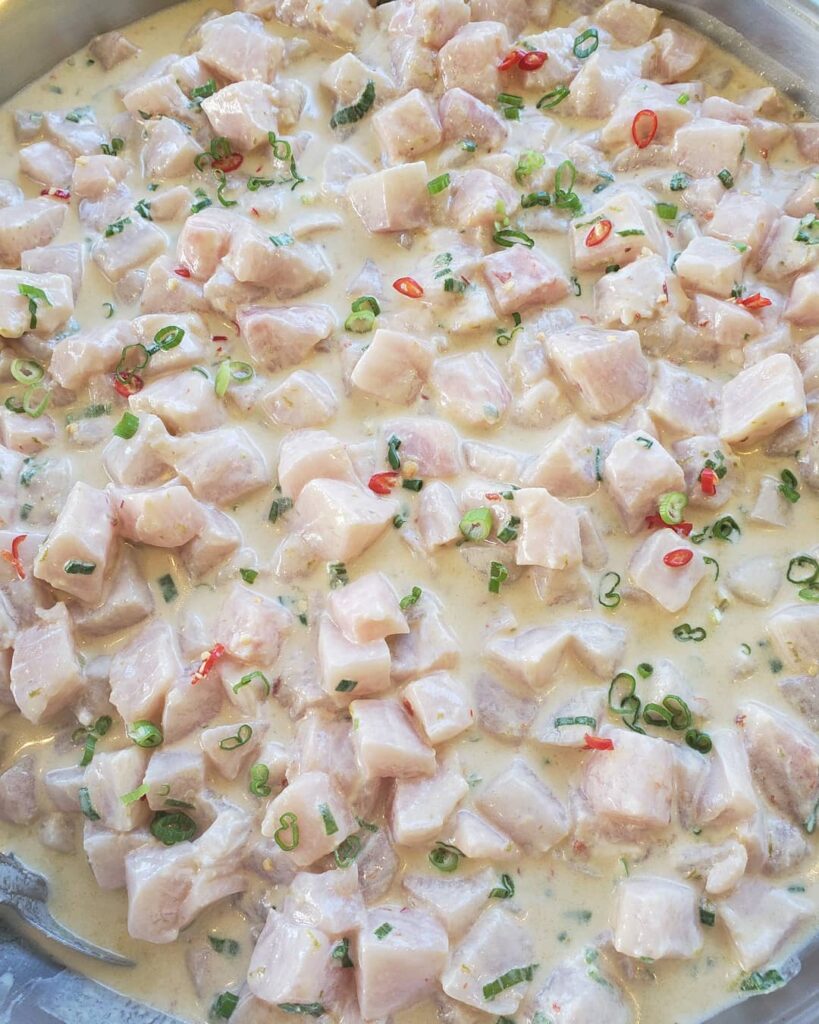
The next was Oka which is a Samoan version of ceviche.
It is basically a raw fish salad with the recipe changing from place to place and no two alike.
The main thing is fresh raw fish, coconut milk/cream and citrus with the option of chilli and anything else you may wish to add.
Being on an island, the seafood is to die for and by Aussie standards is dirt cheap. It is truly the catch of the day, both at the markets and in the restaurants. It has been clear, from our time here in Samoa, how little of the fish that we get back at home is truly fresh.








The main thing that was eaten was fresh fish, often raw, in a Japanese sashimi style or as oka. And it was magnificent. Then you add the cooked stuff and it too was amazing. For a bloke who has always loved seafood (especially the shellfish) this fish stuff is pretty ok too.
As one of our last meals, we were taken to the other side of the island where we had lunch on the water at a Filipino beach shack. This brought into play the crispy pork goodness that is Lechon and crispy pata. Add this to the fish and selection of dips with taro chips and another fantastic meal was had.
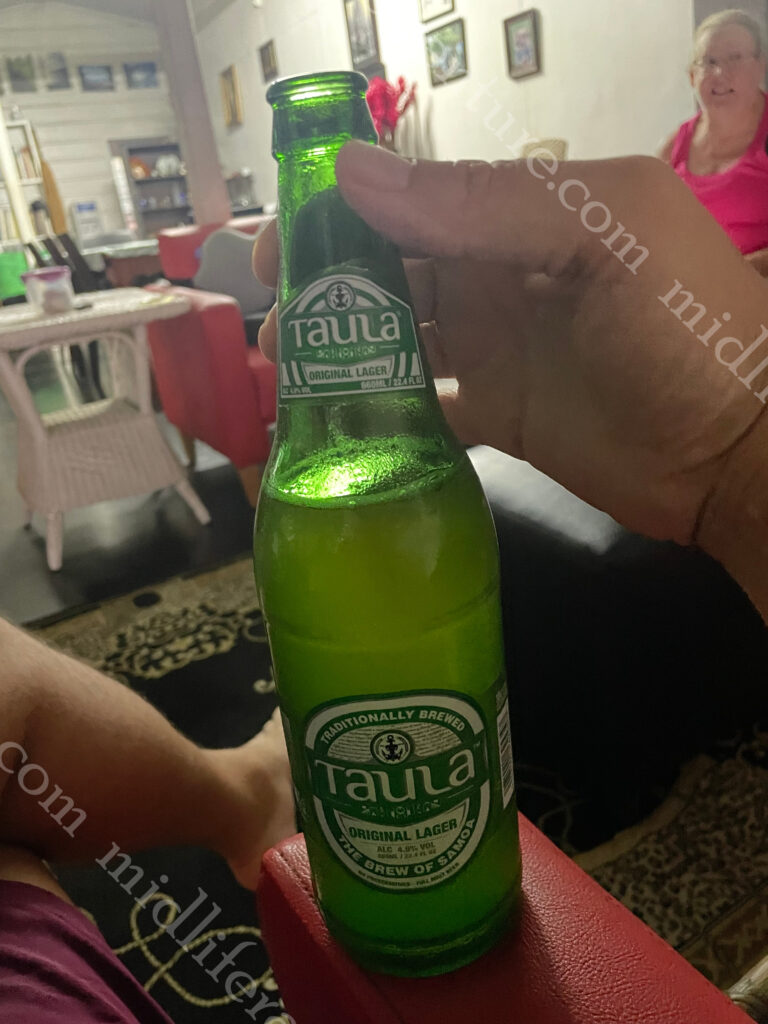
Samoan beer was a bit hit-and-miss.
We only found two real beers and one was good (Taula) and the other (Vailima) we had one and never tried again.
If I was to be harsh, the only real detraction that we came across while in Samoa was the free-range dogs. This was also an issue in Sri Lanka and many parts of Asia. But here we were met with some that were a touch more aggressive than those elsewhere. For the most part, they just wander about harmlessly, but others…not so much. it got to the point that if we were going out after dark, we would have to walk with a stick to protect from the dogs.
The thing that really needs to be mentioned is the Samoan people. At no point in time did we ever feel upset or unsafe (except maybe from the dogs). Everywhere we went we were met with huge smiles and welcoming tones. Our first foray into the bar saw us best friends with almost everyone and when we returned the next day we were welcomed like old friends.
On 31 May 2023 the central bank of Samoa issued the commemorative 60 Tala note, commemorating Samoa’s 60th Anniversary of Independence.
It honours the first Prime Minster and Independence Day in 1962 while embracing the future with the first female Prime Minister 60 years later.
The banknote honors and recognises Samoa’s core strength as its foundation in God.
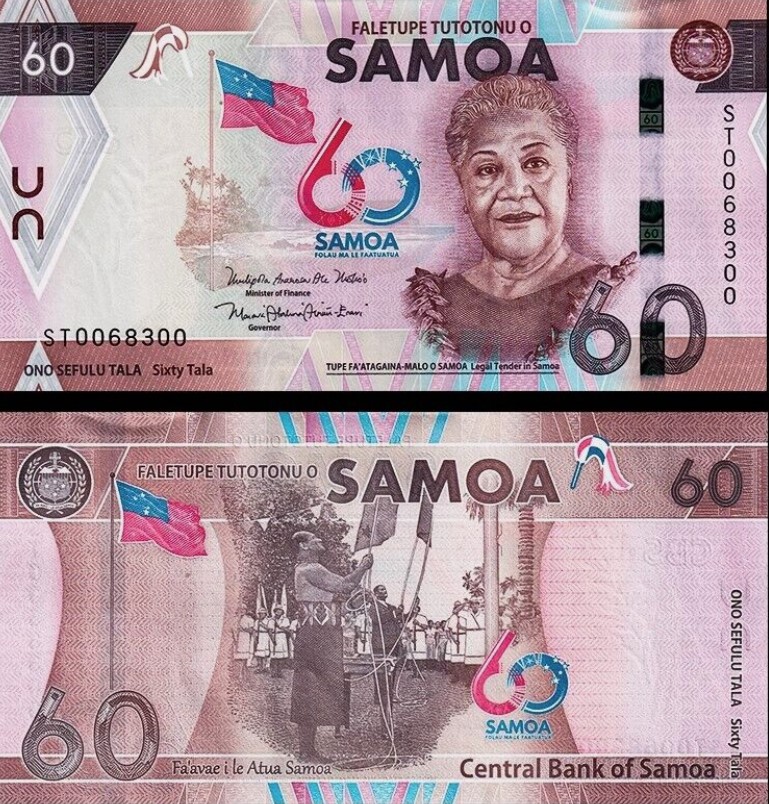
We enjoyed every second of being in Samoa, and the extended timeframe allowed us to truly embrace the place rather than just dart about seeing the tourist highlights. This is a place we would both (and likely will) return to.